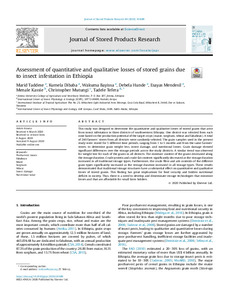| dc.contributor.author | Taddese, M. |
| dc.contributor.author | Dibaba, K. |
| dc.contributor.author | Bayissa, W. |
| dc.contributor.author | Hunde, D. |
| dc.contributor.author | Mendesil, E. |
| dc.contributor.author | Kassie, M. |
| dc.contributor.author | Mutungi, C. |
| dc.contributor.author | Tefera, T. |
| dc.date.accessioned | 2022-08-26T10:30:50Z |
| dc.date.available | 2022-08-26T10:30:50Z |
| dc.date.issued | 2020-12 |
| dc.identifier.citation | Taddese, M., Dibaba, K., Bayissa, W., Hunde, D., Mendesil, E., Kassie, M., ... & Tefera, T. (2020). Assessment of quantitative and qualitative losses of stored grains due to insect infestation in Ethiopia. Journal of Stored Products Research, 89, 101689: 1-7. |
| dc.identifier.issn | 0022-474X |
| dc.identifier.uri | https://hdl.handle.net/20.500.12478/7699 |
| dc.description.abstract | This study was designed to determine the quantitative and qualitative losses of stored grains that arise from insect infestation in three districts of southwestern Ethiopia. One district was selected from each zone based on the production potential of the target crops (maize, sorghum, wheat and fababean). A total of 240 farmers’ stores from all districts were randomly selected. The grain samples used in the present study were stored for 5 different time periods, ranging from 1 to 5 months and from the same farmers’ stores, to determine grain weight loss, insect damage, and nutritional losses. Grain damage showed significant differences over the storage periods across the study districts. A similar trend was observed for weight loss for each of the grains in all districts. The moisture content of the grains decreased along the storage duration. Crude protein and crude fat contents significantly decreased as the storage duration increased in all traditional storage types. Furthermore, the crude fibre and ash contents of the different grain types significantly increased as the storage duration increased in all storage types. These results demonstrated that traditional storage structures have a substantial effect on quantitative and qualitative losses of stored grains. This finding has great implications for food security and hidden nutritional deficits in society. Thus, there is a need to develop and disseminate storage technologies that minimize losses and that are affordable for small farm holders. |
| dc.description.sponsorship | Department for International Development, United Kingdom |
| dc.description.sponsorship | Swedish International Development Cooperation Agency |
| dc.description.sponsorship | Swiss Agency for Development and Cooperation |
| dc.description.sponsorship | Ethiopian Government |
| dc.format.extent | 1-7 |
| dc.language.iso | en |
| dc.subject | Postharvest Losses |
| dc.subject | Faba Beans |
| dc.subject | Maize |
| dc.subject | Sorghum |
| dc.subject | Wheats |
| dc.subject | Insecta |
| dc.subject | Nutritive Value |
| dc.title | Assessment of quantitative and qualitative losses of stored grains due to insect infestation in Ethiopia |
| dc.type | Journal Article |
| cg.contributor.crp | Maize |
| cg.contributor.affiliation | Jimma University College of Agriculture and Veterinary Medicine |
| cg.contributor.affiliation | International Centre of Insect Physiology and Ecology |
| cg.contributor.affiliation | International Institute of Tropical Agriculture |
| cg.coverage.region | Africa |
| cg.coverage.region | East Africa |
| cg.coverage.country | Ethiopia |
| cg.coverage.hub | Eastern Africa Hub |
| cg.researchtheme | Social Science and Agribusiness |
| cg.identifier.bibtexciteid | TADDESE: 2020 |
| cg.isijournal | ISI Journal |
| cg.authorship.types | CGIAR and developing country institute |
| cg.iitasubject | Agribusiness |
| cg.iitasubject | Food Security |
| cg.iitasubject | Grain Legumes |
| cg.iitasubject | Maize |
| cg.iitasubject | Nutrition |
| cg.iitasubject | Pests of Plants |
| cg.iitasubject | Plant Production |
| cg.iitasubject | Value Chains |
| cg.journal | Journal of Stored Products Research |
| cg.notes | Published online: 15 Sept 2020 |
| cg.accessibilitystatus | Limited Access |
| cg.reviewstatus | Peer Review |
| cg.usagerightslicense | Copyrighted; all rights reserved |
| cg.targetaudience | Scientists |
| cg.identifier.doi | https://dx.doi.org/10.1016/j.jspr.2020.101689 |
| cg.futureupdate.required | No |
| cg.identifier.volume | 89 |

